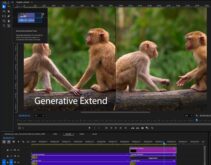2015 was a tumultuous year for codecs. HEVC seemed like a sure thing in January, looked to be in trouble in July, but was happily resuscitated in December, albeit with some missing productive months from its useful life. Open source codecs began the year with the entropy normal only in the codec world, as entities with clearly aligned goals evolved in completely different directions. Then, in the rarest of occurrences, the companies reversed course and converged toward a single standard, which almost certainly helped shove HEVC back on its intended path. Along the way, there were some interesting new technologies making the usual bold (and unproven) claims of pristine quality at seemingly impossible data rates (PERSEUS, Tveon). In case you missed it all, here is your codec year in review.
At the start of the year, HEVC turned 2 years old, and there was a single royalty pool from MPEG LA that charged $0.20 per unit for encoder and decoder after the first 100,000 units, with a $25 million cap in the first year, and no royalties on HEVC-encoded content. Several services had already deployed HEVC content, most famously Netflix with House of Cards.
On the open source front, Google was delivering about 30 percent of all content via VP9 to save big on bandwidth and improve the quality of lower-bitrate files. In October 2014, the Internet Engineering Task Force (IETF) sponsored the Internet Video Codec (netvc) working group, with a goal of delivering the specification for a competitive open-source codec by May 2017. One proposed codec was Daala, a collaboration between Mozilla and Xiph.org. Daala was making progress, but it wasn’t close to commercial availability. The other candidate was VP10, the next-generation codec after Google’s VP9.
Contents
Pre-NAB Announcements
On March 26, HEVC Advance, an independent licensing administrator, announced a new HEVC patent pool with an initial list of licensors that was expected to include GE, Technicolor, Dolby, Philips, and Mitsubishi Electric. The new company promised to announce royalty rates and licensing terms in the second quarter of 2015

Happy people on the HEVC Advance website. Clearly they weren’t discussing feedback from the company’s first proposed licensing structure.
On April 1, V-Nova, a London-based company founded in 2011, announced the new PERSEUS codec, which, according to the press release, offers “UHD quality at HD bitrates, HD at SD bitrates, and SD video at audio bitrates.” Streaming Media has asked repeatedly to test PERSEUS, and V-Nova has declined, though before IBC, the company claimed that it was “working with a number of operators” to trial and evaluate Ultra HD using its PERSEUS codec.
On Nov. 23, 2015, V-Nova announced that Spanish broadcaster MediaPro Overon deployed a PERSEUS-powered product to deliver a contribution stream from a soccer stadium to the Overon control room. According to the release, PERSEUS delivered an Ultra HD stream at 240Mbps with “visually lossless” quality.
Certainly, proprietary technologies such as PERSEUS have the smoothest path toward success in closed-loop markets, and it’s good to see V-Nova making progress. But neither the closed-loop application nor data rates presage PERSEUS’ release—at least not anytime soon—into general purpose streaming markets, where data rates are much lower, and details—for instance, licensing and compatible decoders—complicate productization and market penetration. At this point, PERSEUS remains an outlier—neither standards-based nor open source—and without third-party tests, it’s difficult to determine its potential.

V-Nova was launched on April Fools’ Day. This, and the company’s aggressive claims, gave many compression pundits pause.
Breaking the Camel’s Back
On July 21, HEVC Advance announced its licensing terms. Briefly, encoder/decoder pricing, whether in hardware or software, ranged from $0.80 per unit to $1.50 per unit, with no de minimis exceptions and no caps, backdated to the technology’s first use—take that, you pesky early adopters! HEVC also claimed a 0.5 percent royalty on attributable revenue, essentially a royalty on HEVC-encoded content.
Industry reaction to the proposed royalty was almost uniformly negative on multiple fronts.
Writing for the Streaming Media blog, Dan Rayburn pointed out that HEVC Advance is long on claims but short on details. Potential licensees also vehemently rejected the content royalty. For example, Joe Inzerillo, the CTO of MLB Advanced Media, told Fierce Cable, “The notion of gross revenue is the part that’s just a non-starter. If it was just another toll to pay and the toll was sort of reasonable … that wouldn’t be such a big deal. But the gross revenues … no mainstream company is ever going to do that.” Inzerillo went on to say, “The H.265 patent stuff has really taken the wind out of 4K sales and 8K.
On the encoder/decoder side, it was also unclear whether HEVC Advance’s proposed royalty rates, which exceed those proposed by MPEG LA by as much as 10 times over, would withstand a FRAND (Fair, Reasonable, and Nondiscriminatory) challenge as required for technologies used in an industry standard. With companies such as Apple looking at a $120 million first-year payout, a FRAND challenge seemed almost assured.
Finally, as Rayburn wrote in the blog post mentioned above, a third HEVC licensing group was also forming. Suddenly, HEVC morphed from fait accompli into an unmanageable mess. Meanwhile, behind the scenes, the open source community was making plans to consolidate its efforts. But first, there was Thor.
On the Open Source Front
On Aug. 11, Cisco announced Thor, an open-source codec the company submitted to the aforementioned IETF NetVC workgroup. Given that Thor was “years away,” the announcement had the feeling of being more sizzle than steak. Still, that didn’t stop The Broadcast Bridge from breathlessly trumpeting, “Cisco to Nix HEVC with Thor?” At least there was a question mark in the title.
However, the big news came on Aug. 31, when a new consortium called the Alliance for Open Media announced that it’s working on a codec that could be delivered as soon as January 2017. The group includes a number of notable companies, including Google, Amazon, Cisco, Microsoft, Mozilla, Netflix, Amazon, and Intel, and all agreed to forgo royalties on their IP contributions.

The Alliance for Open Media made a big splash, and might have pushed HEVC Advance back toward success.
Significantly, the group consolidated the development of the three major IETF next-gen codecs (VP10, Daala, and Thor), perhaps forever cementing Thor’s place as the world’s shortest-lived video codec. More to the point, this should accelerate the development of the Alliance codec, and assure its selection as the NetVC codec for the IETF.
What are the Alliance codec’s chances? As discussed in this commentary, the standards-obsessed broadcast market will likely stick with HEVC. However, given the rates initially proposed by HEVC Advance, the Alliance codec really looks like a threat to HEVC in browser-based playback.
All this, of course, assumes that the Alliance codec doesn’t infringe upon any HEVC or other patents, which is a real possibility, according to Elvir Causevic and Ed Fish of Black Stone IP, an investment bank that advises operating companies on trading intellectual property and technology assets.
Causevic and Fish posit that the true purpose of the Alliance might be to create “a dialogue among HEVC Advance and leading IP holders and implementers to arrive at terms that meet the needs of all key parties in each industry segment.” In other words, come to your senses and don’t kill the golden goose before it starts laying eggs. According to Streaming Media editor Eric Schumacher-Rasmussen, this was the talk at IBC—that the Alliance is purely a political move, designed to get HEVC Advance to back down. You’ll see in a moment whether this turned out to be the case.
4K at Under 2Mbps?
In October, Canadian-based Tveon Systems came out of the shadows, and in Videonet, claimed the ability to “deliver 4K-resolution UHD TV at below 2Mbps, and ‘true’ 1080p images at below 200Kbps.” In the article, CEO Scott Hayward explained that Tveon’s codec was based on building algorithms that showed how the brain interprets what the eye is seeing and how it is perceived, calling it a “persuasive-based” algorithm.
In a later article in the Broadcast Bridge, Hayward said Tveon is obtaining independent verification of its claims, with trials expected to start by the end of 2015, and the official launch of the codec toward the end of 2016. A quick check of the website in early January showed no further progress on either of these goals.
Back to HEVC
On Sept. 24, HEVC Advance issued a release stating that it was adding MediaTek as a member of the patent group and that it will “adjust fees to support widespread use of HEVC.” Then on Dec. 18, HEVC Advance issued new terms, which differed from the original terms in four key ways:
– It would reduce the royalty rates on devices and institute an annual cap of $40 million.
– It would eliminate the concept of royalties on attributable revenue and impose a content royalty (with a separate $5 million cap) only on subscription, pay-per-view, and digital media. There would be no royalty on free on-air or streaming video, even if it is advertising-supported.
– It would provide a structured incentive (with both carrots and a big stick) for potential licensees to quickly adopt the new license structure.
– It would provide a royalty credit of $25,000, essentially a de minimis exception for low-quantity use.
“The original pricing and structure was simply untenable, and it wasn’t just us; I think the entire industry felt that way,” Inzerillo, one of the harshest critics of the original terms, said at the time. “It definitely had a chilling effect, and HEVC might have lost 6 months from a development perspective. The new terms are structurally very encouraging, and far more in alignment with common practices and how companies think about pricing. It’s a lot closer to MPEG LA, whose terms were almost universally embraced.”
Inzerillo did caution that he hadn’t seen final licensing terms for indemnification, or how HEVC Advance would protect its licensors from third-party claims, or answers to other critical questions. But, at least from a business perspective, he found the revised plan workable.
HEVC Advance CEO Peter Moller cited, as motivation for the changes, “The first rate structure was impinging the adoption of HEVC, which was the complete opposite of what we hoped to achieve. Clearly our first structure didn’t satisfy many potential early adopters and we needed to fix that.” Regarding the impact of the Alliance for Open Media on the change, Moller explained, “The codec proposed by the Alliance didn’t motivate the change. But there are substantial companies in the Alliance who were refusing to adapt HEVC and said the terms were delaying adoption. That was motivating.”
The short-term impact of HEVC Advance’s first licensing pass is unclear; beyond Microsoft Edge, which according to www.netmarketshare.com had a 2.25 percent penetration as of December 2015, there are no browsers that support HEVC playback. Whether that would have changed had HEVC Advance initially proposed its second licensing package is anyone’s guess.
Though Apple has incorporated HEVC capabilities in multiple devices, starting with the iPhone 5, HEVC appears to be used exclusively for FaceTime, not for video decode, and HEVC is still not listed on any spec sheet. Though HEVC made its way into Android 5.0, this doesn’t seem to have triggered an avalanche of HEVC content to these devices. Clearly, HEVC is doing well for streaming 4K movies to SmartTVs, though only a handful of producers serve this market. But for the average company producing video for a website, HEVC is no closer today than it was in the beginning of 2015.

Even Netflix can’t sustain more than 3.89 Mbps from these top tier ISPs.
That said, it’s not like VP9 is being adopted en masse, though clearly interest was higher between the first and second HEVC Advance announcements. Perhaps it’s UHD that’s not making progress in the streaming space, which makes sense, since relatively few homes can sustain the 16Mbps download speed necessary for 4K, and few streaming producers other than subscription services can justify the bandwidth costs. Maybe 1080p at 4–5Mbps, or 720p at 2.5Mbps, both encoded with H.264, or even smaller, slimmer streams, are all the streaming market needs for now. After all, the Netflix ISP Speed Index still shows the top average sustainable data rate of 3.89Mbps. Some services are starting to cap bandwidth, which only increases pressure to make video streams as efficient as possible.
In that regard, perhaps now that the HEVC royalty issue is settled (other than the grassy knoll vision of a third royalty pool), we’ll start to see HEVC playback incorporated into more and more browsers, which will stimulate the use of HEVC for bandwidth reduction, as opposed to 4K delivery.
This article appears in the 2016 Streaming Media Industry Sourcebook.
 Streaming Learning Center Where Streaming Professionals Learn to Excel
Streaming Learning Center Where Streaming Professionals Learn to Excel









